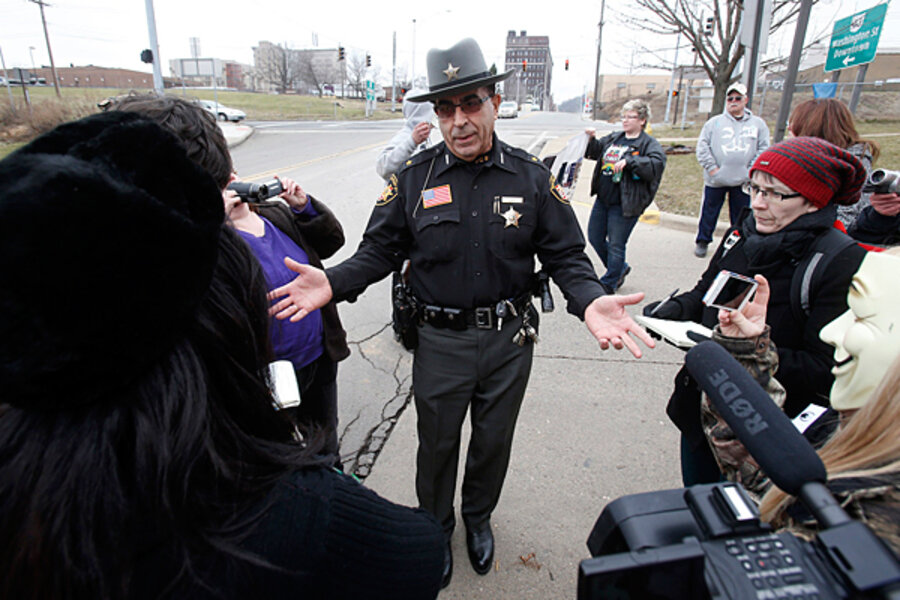Steubenville rape trial: why media came under fire – and what is at stake
| Los Angeles
Just as the Steubenville rape trial has highlighted the need for the responsible use of new media, the mainstream media’s coverage of the sensitive case has also fallen short, adding to a record level of mistrust for national media, say a range of industry watchdogs.
The story involves two minor boys, star athletes who were convicted over the weekend of raping a 16-year-old girl during a night of drunken partying in August.
Social media images from that night went viral – one 12-minute video made by another participant full of graphic descriptions of the night has garnered nearly 1.2 million hits.
But in rushing to cover the verdict, at least two major cable outlets have come under fire for serious on-air missteps.
Fox News has been widely criticized for crossing what most media regard as a clear-cut line by using the underage victim’s name on air.
But CNN, the flagship of 24-hour news, has also become the target of widespread online outrage for its extended coverage following the verdict. In various segments, respected CNN anchor Candy Crowley discussed the verdict with her team of reporters and analysts, using words such as “tragedy” to describe the impact – not on the young victim – but on the lives of the two convicted boys.
Reporter Poppy Harlow said, it was “incredibly difficult even for an outsider like me to watch what happened as these two young men that had such promising futures, star football players, very good students, literally watched as they believe their life fell apart.”
The discussion continued along these lines, including legal analysis of the permanent requirement to register as sex offenders. There were no comments from the victim or from rape advocacy groups.
Within a day at least three online petitions reacting to CNN’s coverage sprang up, calling it “awful” and calling for redress. By Tuesday the petitions had gathered some 200,000 signatures. The verdict that the judge handed down was justice – not a "tragedy," one petition reads, adding, “the tragedy was the rape. Please apologize and make this right.”
CNN executives have spoken anonymously to trade outlet The Wrap, defending Ms. Harlow, but have not officially responded to the petitions. CNN also has not answered Monitor requests for comment. But, say media watchers, there is a cautionary tale for all broadcast media in this moment.
“It used to be that if you made mistakes, you had consequences for them. People lost their jobs, and faith was somewhat restored, ” says former ABC and CBS newsman John Goodman, now a public relations professional in New York. But now, he says, the pressures on commercial media are driving down traditional journalistic standards to the point where mistakes are made and nothing happens. “We all just move on.”
With trust in the media at an all-time low, he adds, mainstream outlets cannot afford to lose more viewers over instances such as these.
TV news is driven by visuals, points out Robert Thompson, founder of the Bleier Center for Television and Popular Culture at Syracuse University in New York. “As newsroom budgets are slashed, the story that arises from wherever the visuals are most compelling is the narrative that will dominate,” he points out. “The courtroom with the two boys and their families is where the cameras were pointed,” says Prof. Thompson.
“This was the drama that was unfolding at the moment that the verdict was read, and this is the narrative that was being captured,” he says, noting that the victim in a highly sensitive case such as this is not present. So unless the media outlet makes a conscious effort to balance the coverage, he adds, “her story is not part of the narrative.”
“This is the news that was breaking,” adds Brett Pulley, dean of the Scripps Howard School of Journalism and Communications at Hampton University, in Virginia. He points out that since this case was not in the public eye over a sustained period of time due to the underage defendants, the national media entered the story at an explosive moment for the accused. “The verdict was what everyone was focused on, this is where the cameras were all trained, he says, “this was the national news, not the victim.”
But, says Mark Tatge, journalism professor at DePauw University in Greencastle, Ind., the intensity of a highly-telescoped trial puts an even larger burden on the traditional media to get the coverage right.
“Mainstream media, in particular broadcast media, have become very narcissistic, very inner focused on the moment, with less and less emphasis on facts and reporting,” he says, and more on competing with a social media environment that fosters more opinion and personality with fewer facts. The mainstream institutions have a bigger responsibility than ever in this environment, he points out, adding, “they are eroding standards and their positions.”
Outlets such as The New York Times or CNN “should be setting the standards and leading the way so that there are still examples for newer media to follow,” he says.
CNN needs to step up to the plate, says Gene Grabowski, Executive Vice President of LEVICK, a Washington-based, crisis management firm. “They have absolutely nothing to gain from standing up to these groups on this issue and appearing to be boorish or insensitive to the victim in a rape case,” he says, adding, “it would be something else if this were some fringe issue, but it’s not.”
This is a particularly sensitive issue, he says. CNN itself is in the midst of a larger upheaval. Former NBC entertainment chief Jeff Zucker has recently been installed to staunch CNN’s ratings slide. “Restoring trust” is vital for an industry under fire, adds Mr. Grabowski.





